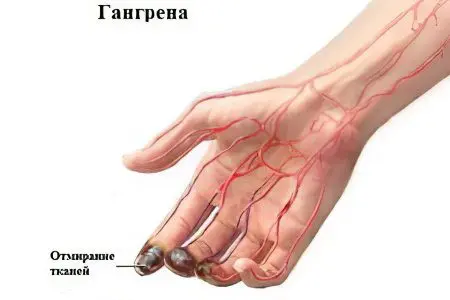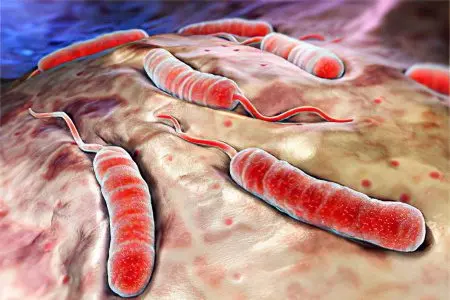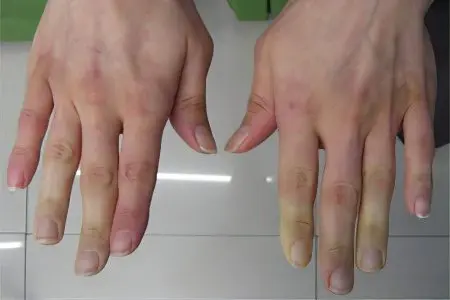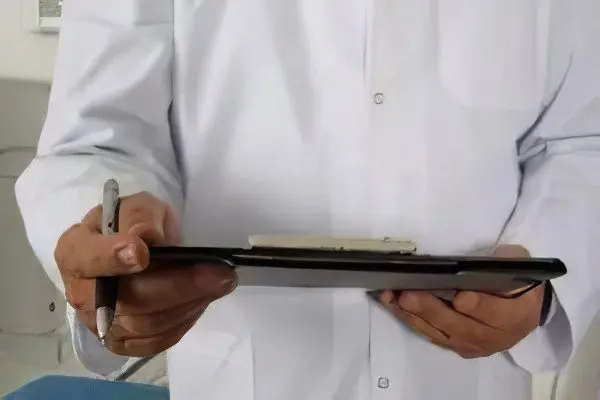Contents
Tissue necrosis due to the cessation of their blood supply, not accompanied by exposure to infectious factors, is called dry gangrene. Its characteristic features are loss of moisture in the affected segment, loss of sensitivity and the possibility of self-healing as a result of rejection of the necrotic area.
How does dry gangrene occur?

This disease is most often diagnosed in patients with asthenic physique, lean, with a minimum moisture content in soft tissues. Another prerequisite for the formation of this particular type of gangrene is the absence of an infectious component. When pathogenic bacteria are involved in the process, dry gangrene turns into a wet form.
The dry variety of necrosis is not accompanied by the development of large-scale intoxication of the body, and the patient feels much better than with other types of this disease, although he experiences severe pain at the beginning of the process. The prognosis of dry gangrene is much more favorable than that of the wet or anaerobic form of pathology. If the patient receives timely medical care, he certainly manages to avoid a fatal outcome.
Most often, dry gangrene occurs on the tissues of the extremities, although it can also develop on the internal organs. If in the first case the affected area is rejected, then in the second the dead zone is replaced by connective tissue. Dry gangrene does not occur spontaneously, its root cause is always trauma or pathology of the vascular system.
On the causes of the formation of dry necrosis

The infection almost never develops in areas of the body with a minimum moisture content, since in this case there are no conditions for the reproduction of pathogenic bacteria. A minimum of fluid is a prerequisite for mummification of the affected limb segment.
Reasons for the development of dry gangrene:
Thermal factors – burn or frostbite (prolonged exposure to cold at temperatures below -15 ° C).
Exposure to high voltage electric current – most often necrosis occurs at the points of entry and exit of an electric discharge, as well as in burned tissues.
Exposure to concentrated acids or alkalis, as a result of which tissue protein coagulates and a zone of dry necrosis occurs.
Violation of the blood supply to the extremities in patients with diabetes mellitus, atherosclerosis, obliterating endarteritis, dystrophy.
Thrombosis, embolism, vascular injury in malnourished patients, although the same diseases in corpulent patients of a loose constitution, other things being equal, would cause wet gangrene.
In order for the pathological process of necrotization to start, a combination of predisposing factors is required. This is the absence of an infectious component, the anatomical and physiological characteristics of the patient, the parameters of the external environment.
Anatomical and physiological features that increase the likelihood of developing dry gangrene:
Intoxication;
Infectious disease in history;
Exchange disorders;
Change in blood composition, anemia;
Exhaustion, prolonged stay in conditions of hunger, cold;
Heart failure;
Dehydration.
Local factors that increase the risk of developing the disease:
Anatomical features of the bloodstream;
The presence of a hematoma that compresses the arteries;
Diseases leading to negative transformation of the vascular wall (atherosclerosis, endarteritis);
The presence of a vascular anastomosis;
Gradual disturbance of blood circulation, in contrast to the rapid changes in the wet form of the disease.
External factors leading to dry gangrene:
Rapid cooling of the injured limb – vasospasm impairs blood circulation;
Excessive warming of the damaged area – acceleration of metabolic processes, combined with a lack of blood for a full supply of tissues, leads to the formation of necrosis.
If an infection occurs in the area where dry gangrene develops, the process transforms into a wet form of necrosis.
How does dry gangrene manifest itself?

At the beginning of the disease, tactile, temperature, kinesthetic sensitivity decreases at the site of future necrosis. The skin becomes dry, hair growth stops on it and they begin to fall out, the range of motion of the fingers and the entire limb is significantly reduced. Even during the heat, the patient complains that the limb cannot warm up. Non-healing ulcers appear on the skin, small wounds and abrasions heal very slowly.
With the development of the disease, the following symptoms appear:
Severe pain that lasts until the complete death of nerve cells;
The skin of the limb turns pale, acquiring a marble hue;
Numbness appears, a limb or its separate segment loses sensitivity;
The diseased limb is much colder than the rest of the body;
The functionality of the limb is completely impaired;
Fabrics wrinkle, lose moisture, become more dense;
The affected area becomes black or dark brown, due to the breakdown of blood components;
Necrosis slowly spreads from the periphery to the center until it reaches the site of blockage of the arteries.
A characteristic feature of dry gangrene is the presence of a demarcation shaft separating healthy tissue from the site of necrosis. At the same time, the general condition of the patient almost does not worsen, because a minimum amount of toxins is released into the blood, or there are none at all.
Diagnostics

With signs of dry gangrene, you should contact a vascular surgeon or a general surgeon. If the disease is caused by a burn, the patient needs to consult a combustiologist. The clinical manifestations of dry gangrene are usually not in doubt, especially if the patient’s history includes injuries to the limbs or pathologies of the vascular system.
For a refined assessment of the state of the vessels and determining the treatment strategy, the following studies are prescribed:
CT-arteriography;
Dopplerography;
Phlebography;
Angiography;
Magnetic resonance imaging of blood vessels.
Additionally, laboratory tests may be prescribed – a blood test for sterility to exclude sepsis, a biochemical and complete blood count.
Treatment methods for dry gangrene

At the initial stages of the disease, attempts are made to restore blood circulation at the site of vascular damage.
For this, the following drugs are used:
Analgesics;
Drugs to improve blood circulation and destroy blood clots;
Immunostimulants;
Vitamin complexes;
Antiseptics to prevent the development of wet gangrene;
Novocaine blockade to relieve spasm of collateral vessels.
If this set of measures does not give a tangible result, the attending physician decides to start removing the necrotic areas. If you wait for their independent rejection, you can provoke the transition of the condition into wet gangrene, which is life-threatening for the patient, so the dead parts of the limb or other organ are removed.
After the operation, the possibility of reconstructing the limb or its segments is considered on an individual basis. To prevent the appearance of dry gangrene, frostbite should be avoided, vascular pathologies should be treated in a timely manner.









